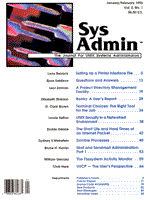
Figure 12: The uustat command
Version 2 Options -c hours Remove jobs from the uucp queue which are older than the specified number of hours. -j jobid|all Prints the uucp status for the specifed jobid. If the keyword is all, then it reports on all of the jobs queued. -k jobid Kill the specifed job. The job being killed must belong to the user unless he is root. -m machine Report on the accessibility of the named machine. If the keyword all is used , then the status of all of the machines will be reported. -o hour Report on all of the uucp requests which are older than the specified number of hours. -s sys Report the status of all uucp requests for the named machine. -u user Report on the status of all uucp requests for the named user. -v Be verbose in the reporting of the status information. -y hour Report on the status of all uucp requests which are younger than the specified number of hours. HDB Options -a Report on all queued jobs. -k jobid Kill the specifed job. The job being killed must belong to the user unless he is root. -m Report on the accessibility of the machines in the UUCP network. -p Run ps -flp on the currently active UUCP processes. -q Report the number of jobs queued for each of the systems. -r jobid Touch the job files for the specified job id. This has the effect of re-queueing the job. -s system Report on the jobs queued for the named system. -u user Report on the jobs queued for the named user.
|